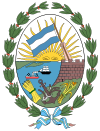Rosario, Santa Fe
Rosario |
|||
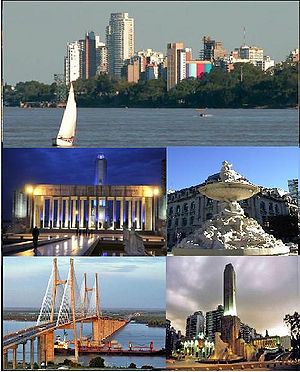 |
|||
|
|||
 |
|||
| Coordinates: | |||
| C | |||
|---|---|---|---|
| Established | 1751 | ||
| Government | |||
| - Mayor | Miguel Lifschitz | ||
| Area | |||
| - City | 178 km² (78.5 sq mi) | ||
| - Land | 203.3 km² (78.5 sq mi) | ||
| Elevation | 22.5 m (74 ft) | ||
| Population (2008 est.) | |||
| - City | 916,000 | ||
| - Density | 5,112/km² (13,240/sq mi) | ||
| - Metro | 1,528,000 | ||
| [1] | |||
| Time zone | ARST (UTC-3) | ||
| - Summer (DST) | ARDT (UTC-2) | ||
Rosario is the largest city in the province of Santa Fe, Argentina. It is located 300 km (187 miles) northwest of Buenos Aires, on the western shore of the Paraná River and has 1,025,000 residents as of the 2001 census [INDEC].
It's the third most important city in Argentina because of the growing and important metropolitan area, a large urban department and for being the most important export centre in the country. It also retains the classical and ancient architecture in some residences, houses and public buildings. It is the third largest city in Argentina in terms of area and population.
Rosario is the head city of the Rosario Department and is located at the heart of the most important industrial corridor in Argentina. Its suburbs and several neighboring towns form the metropolitan area of Greater Rosario, with 1,250,000 inhabitants.
The city is a major railroad terminal and the shipping center for northeastern Argentina. Ships reach the city via the Paraná River, which allows the existence of a 34-feet deep port. The Port of Rosario is subject to silting and must be dredged periodically. [1] Exports include wheat, flour, hay, linseed and other vegetable oils, corn, sugar, lumber, meats, hides, and wool. Manufactures include flour, sugar, meat products, and other foodstuffs. The Rosario-Victoria Bridge, opened in 2003, spans the Paraná River, connecting Rosario with the city of Victoria across the Paraná Delta.
Along with Paraná, Rosario is one of the few Argentine cities that cannot point to a particular individual as its founder. The city's patron is the Virgin of the Rosary whose feast day is on October 7). The asteroid 14812 Rosario was named in its honour.†
Contents |
History


The permanent settlement of the area today occupied by Rosario began in the 17th century. There was no clear foundation date. The first landowner was Captain Luis Romero de Pineda, and the first formal colonial settlement was initiated by Santiago de Montenegro, who was appointed Mayor in 1751.
On 27 February 1812, General Manuel Belgrano raised the newly created Argentine flag on the shores of the Paraná, for the first time.
Until the 1850s Rosario was a small village of 3,000 inhabitants, with its port banned from foreign trade by an 1841 decree of Juan Manuel de Rosas. On 5 August 1852 Rosario was declared a city after a request by Justo José de Urquiza, who also opened up international trade. By 1880, Rosario had become the first export outlet of Argentina and by 1887 it had about 50,000 inhabitants. It was even declared the federal capital on three occasions, but each time this was vetoed by the Executive Branch.
In the last 15 years of the nineteenth century, the city more than doubled its population, in part due to immigration.
In 1911 the French-owned railway company Ferrocarril Rosario y Puerto Belgrano opened a line between Rosario and Argentina's main naval base in Puerto Belgrano. By 1926, Rosario had 407,000 inhabitants, 47% of them foreign, many coming from Europe in the wake of World War I.

In 1946 Rosario massively supported Juan Perón's rise to power. The city received the benefits of the nationalization and subsidizing of many industries. Perón was deposed in 1955. In 1969 workers and students took the streets to protest against the dictatorship (Rosariazo). During the dictatorship started in 1976, hundreds of citizens were "disappeared" by the government.
In 1983 Argentina returned to democratic rule but Hyperinflation caused the economic collapse of the country in 1989. In Rosario there were riots with episodes of looting. Under the Menem administration the situation became worse as the industrial sector of the city was dismantled by foreign competition and agricultural exports stagnated. In 1995 unemployment in the area reached 21.1%, and a large part of Rosario's population fell below the poverty line.
Since the recovery of the national economy that followed the 2001 collapse, Rosario's economic situation has improved. The boom in agricultural exports has caused a large increase in consumer spending and investment. Mayor Miguel Lifschitz's administration is taking advantage of the economic boom to invest heavily in public works, as well as in public health (which takes up about a quarter of the whole budget).
Government

Rosario is ruled by an Executive Branch represented by a Mayor (seat: Palacio de los Leones), and a Legislative Branch, consisting of a Deliberative Council (seat: Palacio Vassallo). The Mayor is elected for a four-year term and the Council renews half of its 21 members every two years.
The city is divided into six large administrative districts (Center, North, Northwest, West, Southwest, and South), with Municipal District Centers that provide services to the citizens.
Local people and institutions have been pushing the provincial government to grant Rosario the status of Autonomous City. Some, with the sponsorship of the governors of Santa Fe, Entre Ríos and Córdoba as well as other important politicians, have put forward a legislative project to move the National Congress to Rosario, to decentralise the national government.
Since the return to democracy in 1983, the Mayors of Rosario were Horacio Usandizaga, Héctor Cavallero, Hermes Binner, and the current one, Miguel Lifschitz (of the Socialist Party, elected in 2003 and re-elected in 2007).
The city does not have a police force of its own (it is served by the provincial police), but in 2004 it lead to the creation of a special patrol force of unarmed officers called Guardia Urbana Municipal ("Municipal Urban Guard") which was imitated later by Buenos Aires in 2005.
Institutions
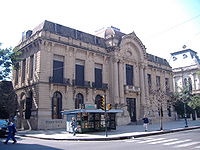
Rosario is an important educational center at a national and international level. It is the home of the National University of Rosario (UNR) since 1968, which includes the Law Faculty, the [UBA|[Medicine Faculty]], the Humanities Faculty and an advanced study centre called Ciudad Universitaria (university city) that is home to more than 10 colleges, including the Faculty of Psychology, the Faculty of Political Sciences, the Faculty of Architecture, etc. It is also home of the Facultad Regional Rosario, a branch of the National Technological University (UTN). All of these national colleges are free. It also has the private colleges, as the Pontifical Catholic University of Argentina (UCA), the Austral University, the University of the Latin American Educational Center (UCEL), the Interamerican Open University (UAI), the Italian University of Rosario (IUNIR), the San Martin University and the University of Concepcion del Uruguay which are private institutions.
Broadcasting and communications
As for television, Rosario has two private local channels, Canal 3 and Canal 5 (the latter is part of the national network Telefé), and a relay station for the public national station, Canal 7 Argentina. Besides, there are three cable TV networks (the national ones Cablevisión and Multicanal, and a local net, Cablehogar), which support two local channels, Canal 4 Noticias and Canal 6.
There are four AM radio stations: three private (licensed by the state) ones, LT3 Radio 2 (LT2), and LT8, and one public, Radio Nacional Rosario, property of the national state. Among the multitude (above 200) of FM stations some notable ones are FM Vida, Estación del Siglo, FM Del Rosario, Cristal FM, Radio Hollywood, Fisherton-CNN, Continental Rosario, Radio 10 Rosario, Radiofónica, Clásica Rosario, etc.
The city has three notable newspapers: La Capital (Argentina's oldest newspaper, founded in 1867, and still published today), Rosario/12 (founded in 1991), and El Ciudadano & la Región (founded in 1999).

Rosario is located at the center of Argentina's optical fiber ring. The main data transport companies offer all their services in the city, from public phones to mobile networks and broadband Internet access through DSL, cable modem and Wi-Fi, and including public Internet navigation centers (cybercafes).
About 96% of homes have a domestic telephone line, giving a total of 472,170 lines; cell phone usage has also become pervasive, as happened in Argentina as a whole since the beginning of the 21st century, reaching over 86% of the residents (866,000 mobile lines in July 2004). This demand, boosted by low prices and sale promotions, and coupled with restrictions on the installation of antennas and alleged lack of investment by the providers, sometimes degrades the quality of the service. Most notably, the mobile network collapsed almost completely in the celebrations of Christmas, New Year's Day and Friend's Day in 2004 and 2005.
Interests
The city has several museums including: the Juan B. Castagnino Fine Arts Museum, the Firma y Odilo Estévez Municipal Decorative Art Museum, the Dr. Julio Marc Provincial Historical Museum, the City Museum, and the Museum of Contemporary Art of Rosario (MACRo). The Dr. Ángel Gallardo Provincial Natural Sciences Museum was rebuilt after a fire in 2003 and re-opened in a new location in 2006. There is a plan to move the National Oriental Art Museum, which currently shares a building with the National Decorative Art Museum in Buenos Aires, to Rosario.
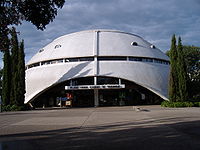
Rosario has a public astronomy complex, located within Urquiza Park, consisting on an observatory (inaugurated in 1970) and a planetarium (1984).
Rosario has a number of public health centers: 5 municipal hospitals (including a children's hospital and an emergency hospital/trauma center) and a municipal outpatient-only center, plus 2 large provincial hospitals (Hospital Provincial and Hospital Centenario), and their associated primary care centers in the city proper and its metropolitan area.
The Rosario Board of Trade hosts the country's largest commodity market, dealing in cereals and oilseeds, and also the largest futures exchange (ROFEX). The banking sector includes the state-owned Municipal Bank of Rosario, with branches and offices throughout the city, and the central branch of the New Bank of Santa Fe.
The Fundación Italia is a cultural institution whose importance has been growing since its creation in 1985. Created by people who boast a "cultural bond with Italy" it has organized a Neapolitan music concert, the play of Madame Butterfly and numerous talks about the present and future of Argentina. Among the people invited to give these talks were economists Domingo Cavallo and Alfonso Prat Gay, renown scholars Beatriz Sarlo and Silvia Bleichmar, journalists Alejandro Rozitchner and Jorge Asís, filmmaker Fernando Solanas and the former presidents of Chile -Ricardo Lagos-, Argentina -Eduardo Duhalde-, and Uruguay -Luis Alberto Lacalle Herrera.
Demographics
Ethnicity

The most common ethnic groups are Italian and Spaniard (mostly Galicians and Basques). There are also significant Germanic, Slavic, British, Irish and French populations.
Waves of immigrants from European countries arrived in the late 19th and early 20th centuries. The main contributors were Spain, Italy, France, Eastern European nations such as Croatia, Poland, Russia, Romania, Ukraine and the Balkans (especially Greece, Serbia and Montenegro), Switzerland, Germany, the United Kingdom and Ireland, and Scandinavia (especially Sweden). By the 1910s, 43 percent of the city population was non-native Argentine after immigration rates peaked.[2][3]
Most immigrants, regardless of origin, settled in the city or around Greater Rosario. However, in the first stages of immigration, some formed colonies (especially agricultural colonies) in diferent parts of the city, often encouraged by the Argentine government and/or sponsored by private individuals and organizations.
Demographic distribution

Rosario is a city ubicated in the province of Santa Fe, Argentina. This metropolis has a population of about 1.5 million (1,528,000 est.), thus being Argentina's second most populated urban settlement, after Buenos Aires[4]
The Greater Rosario comprises Rosario itself (population about 910,000) and a large area around it, spreading in all directions except eastward (because of the Paraná River). Directly to the south it includes the city of Villa Gobernador Gálvez, with a population of about 75,000, at about 10 km from Rosario city centre.
To the west and south-west there are several smaller towns and cities (Funes, Roldán, Pérez, Soldini); Roldán is 23 km from Rosario city centre. These settlements were incorporated into the metropolis due to their vicinity to major roads leading into Rosario, and many people living there habitually commute to Rosario.
The farthest end is to the north, following the coast of the river; from Rosario one finds, in succession and usually merging into each other, the towns of Granadero Baigorria, Capitán Bermúdez, Fray Luis Beltrán, San Lorenzo (already in a different departamento, with a population of over 40,000), and Puerto General San Martín, the last being at a distance of 35 km from Rosario.
The north of the Greater Rosario is one end of an area traditionally called Cordón Industrial ("Industrial Corridor"), since it was traditionally a heavily industrialized productive region. The prelude to the economic crisis in the 1990s largely dismantled the industrial infrastructure and damaged agricultural exports. As of 2006 the recovery of national economy has revitalized them, but high levels of poverty and unemployment persist (the last official survey indicates that 23.4% of the population is under the poverty line).[4]
In 1876 the total population was 203,509 and it doubled in 1908, and yet again in less than two decades; by 1926 Rosario had 407,000 inhabitants, 47% of them foreign, many brought from Europe in the wake of World War I. Most of them were Italian, and among them, a majority from the north-western region of Liguria. As of the census of 2001, there are 1,161,188 people residing in the city and 31 surrounding districts, making metro Rosario home to one in five Argentines[5]. The population density in Rosario proper was 13,680 inhabitants per square kilometer (34,800 per mi2); but, only about 2,400 per km2 (6,100 per mi2) in the suburbs.
The 2001 Census showed a relatively aged population, as well; with 17% under the age of fifteen and 22% over sixty, the people have an age structure similar to those in most European cities. They are, likewise, a good bit more elderly than Argentines as a whole (of whom, 28% were under 15 and 14%, over 60).[5]
Districts
Rosario is divided into six districts, most named by location although the eastmost is called Centre District as it includes the oldest part of the city historicaliy called Centro (City Centre). The data given below are from the 2001 census [INDEC].


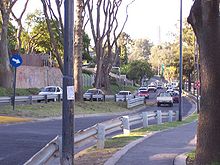
Centre District
Population: 261,047
Area: 20.37 km² (11.45% of the Municipality)
Population density: 12,815 inhab/km²
Housing: 110,152 units
North District
Population: 131,495
Area: 35.02 km² (19.6% of the Municipality)
Population density: 3,744 inhab/km²
Housing: 40,492 units
Northwest District
Population: 144,461
Area: 44.14 km² (24.7% of the Municipality)
Population density: 3,273 inhab/km²
Housing: 41,740 units
West District
Population: 106,356
Area: 40.21 km² (22.5% of the Municipality)
Population density: 2,645 inhab/km²
Housing: 31,625 units
Southwest District
Population: 103,446
Area: 20.19 km² (11.3% of the Municipality)
Population density: 5,123 inhab/km²
Housing: 28,284 units
South District
Population: 160,771
Area: 18.76 km² (10.5% of the Municipality)
Population density: 8,569 inhab/km²
Housing: 48,541 units
Geography and urban structure




Rosario lies on the ravine of the right-hand shore of the Paraná, about 24 m above mean sea level, in a place with a natural slope to the low shore. The point of origin of the city is Plaza 25 de Mayo ("May 25 Square"), now surrounded by the Municipality (Palacio de los Leones), the Basilica Cathedral of Our Lady of the Rosary, the Central Post Office, the Decorative Art Museum and a building called La Bola de Nieve ("The Snowball"). Between the Cathedral and the municipal building is Pasaje Juramento ("Oath Passage"), leading to the Flag Memorial. The streets mostly follow a regular checkerboard pattern.
Córdoba Street begins in the Flag Memorial Park, climbs toward the center, and becomes a pedestrian walk for seven blocks, between Plaza 25 de Mayo and Plaza Pringles. Along Córdoba to the west there is the Paseo del Siglo ("Walk of the Century"), with former houses of wealthy families. There is also Plaza San Martín, and elsewhere, Plaza Montenegro (on Peatonal San Martín, the pedestrian-only four blocks of San Martín Street) and Plaza Sarmiento.
Oroño Boulevard (going north–south) and Pellegrini Avenue (east–west) mark the boundaries of the town center together with the river. At their confluence starts the Parque de la Independencia, that houses the Juan B. Castagnino Fine Arts Museum, the Newell's Old Boys football club, and the sports clubs Provincial and Gimnasia y Esgrima, as well as the horse racetrack and the former Sociedad Rural (Rural Society).
Towards the south, beyond Pellegrini Avenue, there are two more boulevards, 27 de Febrero and Seguí, and avenues Uriburu, Arijón and Battle y Ordóñez.
To the west, after Oroño, there are the avenues Ovidio Lagos and Francia, Avellaneda Boulevard and Provincias Unidas Avenue. The main barrios in the south are La Tablada, Parque Casado, Las Heras, Las Delicias and Las Flores. The city ends in the Saladillo Stream.
Among the barrios in the west are Echesortu, Belgrano, Triángulo, Moderno, Godoy and Fisherton. To the north-east there lie Pichincha, Ludueña, Lisandro de la Torre (home of Rosario Central's stadium) and Empalme Graneros.
Next to the stadium there is the Parque Alem, and nearby the Sorrento thermal power plant. To the north lie the barrios of Alberdi, La Florida (with a popular beach resort of the same name), Parque Field (built under US President John F. Kennedy's Alliance for Progress development plans) and Rucci. The main streets are Alberdi Avenue and its continuation, Rondeau Boulevard (which leads to the Rosario-Victoria Bridge and the city of Granadero Baigorria). These are crossed by the avenues Las Tres Vías, Génova, Sorrento and Puccio.
An important part of Rosario's urban character is its river bank. The city recovered the river bank of the Paraná not long ago, thanks to a reorganization of terrains formerly owned by the port and the national railroad system. Going from the center immediately north of the port, the river bank is occupied by the parks Parque Nacional a la Bandera, Parque de España, Parque de las Colectividades and Parque Sunchales.
Municipal statistics

The municipality of Rosario comprises 178.69 km², of which 117 km² are urbanized, in 6,306 housing blocks. Of this area, 9.37 km² (5.3%) is devoted to green spaces (parks, boulevards, plazas), which gives over 10 m² of green space per inhabitant.
Electric power is supplied to the whole urban area and running water reaches 97% of the population (about 350,000 homes). Natural gas is provided to 227,152 homes.[6]
Since the beginning of the recovery of the national economy, the city is experiencing a real estate boom (as of 2007). In the period 2003–2006, the construction sector has added 2 million m², investing about $900 million. Despite this increased supply, prices have increased by 10% compared to the values during the 1990s, and rents have soared by 165%. Experts believe that this growth is propelled by the increased purchasing power of farmers around Rosario, helped by competitive exports, and the overall preference for safer investment options ("in bricks").[7]
Climate and natural hazards
The Rosario area has a Pampean temperate climate, with average temperatures of 23.4 °C (74.12 degrees Fahrenheit) maximum and 11.6 °C (52.88 degrees Fahrenheit) minimum, and an annual rainfall of 1,038 mm (40.87 in). The winter is short, and snow is almost unheard of (the last instance was in 1973). Serious earthquakes, hurricanes and volcanic eruptions are virtually unknown.
Transportation
Rosario's strategic location is destined to become a significant transportation hub and as the bi-oceanic corridor that links the State of Rio Grande do Sul (Brazil) on the Atlantic Ocean to Valparaíso (Chile), on the Pacific, an important component in global distribution and the core center of a key corridor in the Mercosur, the Common Market for the South.[8]
Public transport




The Rosario public transport system includes buses, trolleybuses and taxicab. The trolleybuses consists of only one main trunk line. Plaza Sarmiento is the hub of the city bus system, about 40 urban lines in the metropolitan area that provide service every 5 to 10 minutes. The bus fare is pre-paid by means of a disposable paper card with a magnetic stripe which can be bought from post offices, automatic vending machines, and private businesses. For occasional use, a larger fare can be paid using a coin machine in the bus unit. The interurban lines have differential fares and some allow payment in cash only.
The urban bus fleet was partially renewed during the recovery of the national economy, since 2003, and consists of about 730 units. In 2005 the average age of the buses was 5 years and 11 months. Improvements in the economy have led to increased use of public transport, and comparatively less use of bicycles. According to the Rosario Transportation Office, in 2005 there were about 11 million bus journeys per month,[9] by 2007, usage has climbed to 420,000 people every day (12.6 million per month).
As a curiosity, Rosario has a large number of buses which run on natural gas, as it happens also in Argentina as a whole, and all gas stations provide it. Its price is quite low compared to the alternatives. The idea to transform all buses to this system did not prosper; most buses run on heavily subsidized diesel fuel.
Rosario has a medium-sized taxi fleet, with units painted black and outlined in yellow. Some belong to radio-taxi companies and can be reserved by telephone; others only in the streets. As the economy of Argentina recovers, the capacity of the taxi fleet has been strained by higher usage. In September 2005, the Deliberative Council approved the compulsory installation of radio-call systems in all taxi units, but this requirement has not been fulfilled.
Rosario is also a major hub for long-distance overland transportation from the Mariano Moreno Bus Terminal,[10] (Terminal de Omnibus), across from the Patio de la Madera Convention and Exposition Centre complex, about 15 blocks west of Plaza San Martin. The transportation facility serves 73 bus companies in short, medium and long-distance travel, carrying 1,100.000 passengers per month to 784 national and international destinations, which comprise most major domestic cities including Puerto Iguazú, Salta and Bariloche and international destinations such as Asunción, Paraguay, Curitiba and Rio de Janeiro, Brazil and Montevideo, Uruguay, destinations may be long but white-clad chauffeurs handle comfortable long-distance coaches with modern conveniences.
Rail
- See also: Buenos Aires-Rosario-Córdoba high-speed railway

The passenger train system was severely damaged by the privatization of most railway companies in the early 1990s, but is slowly recovering. The lines of the Nuevo Central Argentino (NCA) railway company handle most of the cargo. Additionally, two private passenger railway companies provide limited services to several major cities. Trenes de Buenos Aires runs weekly trains south to Retiro Station in (Buenos Aires) and north to Santa Fe. The company Ferrocentral also operates weekly trains south to Buenos Aires and northwest to Córdoba and Tucumán.
There is a project to build a high-speed train between Buenos Aires-Rosario-Córdoba, scheduled to be started in 2008, with a inauguration in 2012, it will join Rosario and Buenos Aires in 85 minutes, and will reach Córdoba in another 90 minutes at speeds of up to 320 km/h (200 mph).[11]
Roadways
Rosario is linked to the rest of the country by a number of roads: the Aramburu Highway (southeast, to Buenos Aires), National Route 9 (from Buenos Aires to Rosario and then north and west up to Jujuy and Bolivia), the Brigadier Estanislao López Highway (north, to Santa Fe City), National Route 11 (to the north of Santa Fe, Formosa and Paraguay), National Route 33 (to the southwest of Santa Fe and the province of Buenos Aires, and then through National Route 7 to San Luis, Mendoza and Chile), National Route 34 (north to Santiago del Estero, Tucumán and Bolivia), and National Route 174 (east, to Entre Ríos, over the Rosario-Victoria Bridge).It is surrounded with an extense highway called Circunvalación which in turn sets the limit of the city.
Airports
The Rosario Airport is located 13 km (8 miles) west-northwest from the center of Rosario, a city in the Santa Fe Province of Argentina. The airport covers an area of 550 hectares (1359 acres) and is operated by the Province of Santa Fe.[12][13]
The airport serves the Greater Rosario area and is the main hub for Sol Líneas Aéreas and is also served by Aerolíneas Argentinas, Gol Transportes Aéreos and LAN Argentina. There are domestic flights within Argentina from Rosario to Buenos Aires, Córdoba, Mar del Plata (via Buenos Aires), Mendoza (vía Còrdoba), Santa Fé and Villa Gesell (via Buenos Aires) cities as well as international services to Santiago de Chile, Porto Alegre, Brazil, and Punta del Este, Uruguay (direct flight in summer and via Buenos Aires in fall, winter and spring). Since June 2008 the Uruguayan airline PLUNA will fly from Rosario to Montevideo (Uruguay). The airport is at an altitude of 82 feet (25 m) and its longest runway measures 9843 feet (3 kilometres).
Port
The Port of Rosario, is an inland port and a major goods-shipping centre of Argentina, located in the city of Rosario, province of Santa Fe, on the right-hand (western) shore of the Paraná River, about 550 km upstream from the Atlantic Ocean.[14] [15]
At this point of the course of the Paraná (Kilometer 420) lies the depth transition between overseas and river navigation. The main channel of the river directly in front of the port has an advantageous configuration that allows to preserve a depth of 34 feet with minor periodic dredging. This allows for downstream navigation of vessels up to Panamax kind. The Paraná is about 600 m wide at Kilometer 418 and becomes 2,000 m wide downstream.
The port is the largest of a series located in the several cities of the Greater Rosario that lie on the Paraná; the last (northernmost) able of overseas traffic being Puerto General San Martín (23 km upstream from Rosario). It is part of the Bi-Oceanic Corridor that joins the Atlantic with the Pacific Ocean via Buenos Aires, Rosario, Córdoba, the Cuyo region and Valparaíso, Chile; going north-south it forms the axis of the Paraguay-Paraná Hydroway. It directly services the area of Santa Fe that produces a large part of Argentine exports, and indirectly the whole Mercosur trade bloc. In 2003 the traffic in the port amounted to 2.9 million tonnes.
Cargo from other parts of Argentina is brought into the port by the railway lines of the Nuevo Central Argentino, communicating with Córdoba (west) and Zárate, Buenos Aires (south), as well as the multiple national and provincial roads and highways that converge in Rosario. Communication with the north-eastern part of the country was enhanced by the 2003 opening of the Rosario-Victoria Bridge, that joins the city with the province of Entre Ríos. The Rosario International Airport (located 15 km east) has also been refurbished to work with cargo traffic.
Sports
Rosario is the home of the football clubs Rosario Central (founded 1889) and Newell's Old Boys (founded 1903), both of whom play in the Primera División Argentina. Rosario Central has won 4 National championships and one official international title (the Copa Conmebol in 1995, the precursor of current Copa Sudamericana). Newell´s has 5 National championships and none international titles. Other Rosario´s football clubs are Club Atlético Central Córdoba, currently playing in Primera B Metropolitana, and Club Atlético Tiro Federal Argentino in Primera B Nacional Argentina.
It is also the hometown of Argentine internationals Ángel Di María, Ezequiel Garay, Maxi Rodríguez, Cesar Delgado, and Lionel Messi.
Rosario is also the second choice site for Argentine rugby tests, after Buenos Aires.
Culture

Rosario is characterized by an intense cultural activity in many art disciplines, with a national and international reach. The city has given Argentina important characters in the fields of music, painting, philosophical and political thought, poetry and prose, medicine, and law.
There are many theaters of varying size and importance, such as El Círculo, the Sala Lavardén, the Broadway, the Astengo, the La Comedia, etc. The theater known as "Puerto de la Musica" -designed by Oscar Niemeyer- will be built alonside the coast of the Parana River. It is projected to be one of the most important theaters in Latin America, and it is scheluded to be completed by year 2010.
Notable people from Rosario
See People from Rosario. This list is not exhaustive.
- Artists and educators Leticia Cossetini and Olga Cossetini
- Artists Antonio Berni, Gustavo Cochet and Julio Vanzo
- Painter and sculptor Lucio Fontana
- Sculptors Erminio Blotta and Guillermo Gianninazzi
- Writer Roberto Fontanarrosa and Jorge Riestra
- Revolutionary and guerrilla leader Ernesto "Che" Guevara
- Singer and actress Libertad Lamarque
- Actors Alberto Olmedo, Darío Grandinetti, Luis Machín and Argentine-Brazilian actress Renata Fronzi[16]
- Singers and composers Juan Carlos Baglietto, Fito Páez, Liliana Herrero (Herrero is from Villaguay, Entre Ríos, but moved to Rosario at 18), Leandro Gato Barbieri, Lalo De Los Santos and Litto Nebbia
- Opera singers,conductor and composer José Cura
- opera singer Felipe Romito
- Chess grandmaster Gerardo Barbero
- Politician Lisandro de la Torre
- Football (soccer) coach Marcelo Bielsa, Edgardo Bauza
- Football (soccer) players Maxi Rodríguez, Ezequiel Garay, Lionel Messi, Luciano Figueroa, Marcelo Delgado, Cristian Gonzales, Cesar Delgado, and Ángel Di María. Former footballer and coach César Menotti is also from Rosario.
- Paleontologist José Bonaparte
- Science fiction author Angélica Gorodischer (born in Buenos Aires, but residing in Rosario since childhood)
- Pianist Daniel Rivera
- Psychoanalyst Juan-David Nasio
Language

Rosario is one of the main urban centers of the Rioplatense Spanish dialect. The intra-dialectal differences with Buenos Aires and other cities in the same area are minimal, though rosarinos aspirate and suppress their final -s more than porteños, and there are also minor lexical variants.
The city has a local language game, sometimes employed as slang, called Rosarigasino (related to jeringonza).
Holidays
- June 20: Día de la Bandera Nacional (National Flag Day). Commemoration of General Manuel Belgrano's death. National holiday. Military and civic parade at the National Flag Memorial, including the world's longest flag (more than 10 km long), which is carried by citizens along the National Flag Park.
- July 20: Día del Amigo (Friend's Day). This celebration of friendship is common throughout Argentina, but especially popular as a mass phenomenon in Rosario, as in other large cities in the country.
- 21 September: Spring Day and Student's Day. National informal holiday for students and young people in general. Even though the precise time of the astronomical spring equinox is variable, seasons in Argentina are conventionally deemed to begin on the 21st day of the corresponding month. People from Rosario usually gather at the city's parks, travel to nearby towns (notably Funes) or cross the Paraná River to visit the island resorts.
- October 7: Día de la Virgen del Rosario (Day of the Virgin of the Rosary, patron of the city). This is a local public holiday and a free day for schools and university students, municipal employees, and employees of the provincial state residing in Rosario. The patron's feast is marked by Catholic celebrations and a procession.
See also: Public holidays in Argentina.
In addition to these official holidays, high school students in the 2000s created a humorous observance, self-styled "holiday", called Día de la Chupina ("Hooky Day"), which is celebrated on the last Friday of April by skipping class altogether and loitering at Rosario city centre.
Events
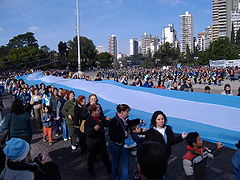
- Festival Latinoamericano de Video Rosario (Rosario Latin American Video Festival). Annual event (September), starting in 1994.
- Encuentro Internacional de Escultura en Madera-Piedra-Hierro de Rosario (International Meeting of Wood-Stone-Iron Sculpture in Rosario). Annual event (September/October), since 1993.
- Encuentro y Fiesta Nacional de Colectividades (Communities Meeting and National Celebration). Annual event, starting in 1985, showcasing music, song, dance, cuisine and customs of foreign communities in Argentina, in the ample room provided by the Parque Nacional a la Bandera (National Flag Park). Usually held in November; in 2004 it was postponed to the beginning of December in order to avoid overlap with the Third International Congress of the Spanish Language.
- Festival Internacional de Poesía de Rosario (International Poetry Festival). Annual event since 1993 (November).
- Festival Iberoamericano de Cine de Rosario (Ibero-American Film Festival). Annual event since 2003 (November).
- Leyendas ("Legends"). A cartoon, role-playing and science fiction convention. Annually since 1999, usually in autumn (April/May), sometimes in spring (November).
Twin cities
Rosario has a number of Twin cities around the world. Sisterhood agreements are intended to foster solidarity and collaboration between cities and regions that share characteristics, historical links or common characteristics.
Rosario, Santa Fe
| Country | City |
|---|---|
| Alessandria | |
| Asunción | |
| Bilbao | |
| Caracas | |
| Dakar | |
| Haifa | |
| Imperia | |
| Manizales | |
| Montevideo | |
| Monterrey, Nuevo León | |
| Piraeus | |
| Pisco | |
| Porto Alegre | |
| Shanghai | |
| Toulouse | |
On July 25 2006, Rosario offered a charter of sistership to Split, Croatia.
References
- ↑ INDEC: estimaciones de población
- ↑ Dinámica migratoria: coyuntura y estructura en la Argentina de fines del XX
- ↑ http://www.buenosaires.gov.ar/areas/hacienda/sis_estadistico/anu_estadistico/01/web01/c110.htm
- ↑ 4.0 4.1 INDEC, 2001 census, updated by the Permanent Home Survey (first semester 2006). Published in La Capital, 21 Sep 2006.
- ↑ 5.0 5.1 2001 Census
- ↑ Municipalidad de Rosario, estadisticas Spanish
- ↑ Government statistics 2 Spanish
- ↑ Mercosur official website
- ↑ Transporte de Rosario Spanish
- ↑ Terminal de Ómnibus Mariano Moreno Spanish
- ↑ TAVe, Buenos Aires - Rosario - Córdoba accessdate=2008-05-12 Spanish
- ↑ (Spanish) SAAR - Rosario / Islas MalvinasPDF at AIP Argentina
- ↑ (Spanish) Aeropuerto Internacional Rosario "Islas Malvinas" at Organismo Regulador del Sistema Nacional de Aeropuertos (ORSNA)
- ↑ Universidad Nacional de Rosario - Details about the Greater Rosario area ports.
- ↑ CONICET - La ciudad y su zona de influencia tienen un polo portuario que atrae inversiones. Overview of the port economy in the Rosario area (in Spanish).
- ↑ "Atriz Renata Fronzi morre aos 82 anos no Rio", Folha (2008-04-15). Retrieved on 2008-05-10.
External links
- Municipality of Rosario (official website)
- Rosario Cursos y Congresos Courses and Congresses in Rosario
- RosarioCity (commercial website of Rosario city and its region)
- Rosario.com.ar (commercial guide to Greater Rosario)
- (English) Ente de Turismo Rosario (tourism office)
- National University of Rosario
- Night life and entertainment
- Rosario Alternativo Short stories for the learned traveller
- (English) Administrative Entity of the Port of Rosario (ENAPRO)
- (English) Rosario Board of Trade (Bolsa de Comercio de Rosario)
- RosarioLinks (web directory)
- La Capital (online newspaper)
- El Ciudadano & la Región (online newspaper)
- Map of Rosario City
